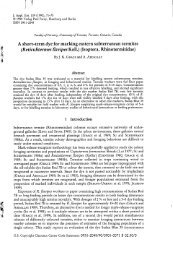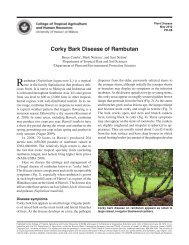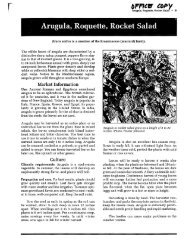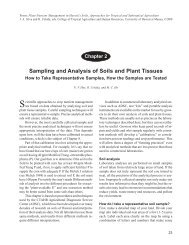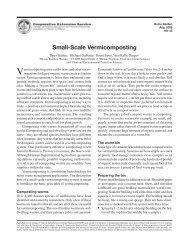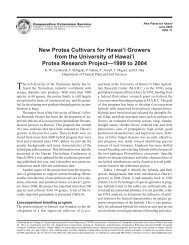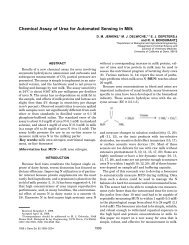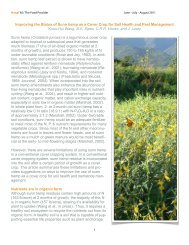Nappa Cabbage, Chinese Cabbage, Celery Cabbage, Pe-tsai - ctahr
Nappa Cabbage, Chinese Cabbage, Celery Cabbage, Pe-tsai - ctahr
Nappa Cabbage, Chinese Cabbage, Celery Cabbage, Pe-tsai - ctahr
Create successful ePaper yourself
Turn your PDF publications into a flip-book with our unique Google optimized e-Paper software.
86 • Specialty and Minor Crops Handbook<br />
<strong>Nappa</strong> <strong>Cabbage</strong>, <strong>Chinese</strong> <strong>Cabbage</strong>,<br />
<strong>Celery</strong> <strong>Cabbage</strong>, <strong>Pe</strong>-<strong>tsai</strong><br />
Brassica rapa <strong>Pe</strong>kinensis Group is a member of the Brassicaceae (mustard) family. Varieties include i_<br />
Che-foo types: Wong Bok, Wintertime, Tropical Pride, Spring Giant, and Tokyo Giant; and the Chihili -<br />
types: Michihili, Jade Pagoda, Market Pride, Shantung, and Shaho Tsai.<br />
There are two principal forms of <strong>Nappa</strong> cabbage.<br />
The Che-foo type (also known as Chiifu or Wong<br />
Bok, and sometimes Napa) develops a compact,<br />
often drum-shaped head slightly taller than it is<br />
wide. The head contains many broad, soft, lightgreen<br />
leaves. In the retail trade, nappa is usually<br />
understood to be this type. The other type, Chihili,<br />
forms a cylindrical head about three times as tall as<br />
it is wide. It has narrow, somewhat coarse leaves<br />
that are darker green than those of the Che-foo<br />
type.<br />
Other names. <strong>Nappa</strong> cabbage is also known as<br />
hakusai (Japanese); pai-<strong>tsai</strong> (Mandarin <strong>Chinese</strong>);<br />
won bok (Cantonese <strong>Chinese</strong>); and pechay or tsina<br />
(Filipino).<br />
Market Information<br />
Current production and yield. <strong>Nappa</strong> cabbage is<br />
available year-round from California and Hawaii.<br />
New York, Florida, New Jersey, Michigan, and<br />
Ohio are seasonal producers; they do not produce<br />
the crop in summer.<br />
Culture<br />
Climatic requirements. <strong>Nappa</strong> cabbage is a coolseason<br />
annual vegetable. It grows best with short<br />
days and moderate to cool temperatures (60° to<br />
70°F mean temperatures).<br />
Flowering (bolting) is favored by exposure to<br />
low temperatures (40° to 50°F) and long days. Such<br />
conditions during growth can cause premature<br />
bolting.<br />
Temperatures greater than 80° to 85°F favor<br />
the development of tip burn, a nonpathogenic dis<br />
order. Compact and mature heads are more sus<br />
ceptible to tip burn.<br />
<strong>Nappa</strong> cabbage packed for market.<br />
(Photo: Vince Rubatzky)<br />
Propagation and care. <strong>Nappa</strong> cabbage is relatively<br />
easy to grow. Plant it either by direct seeding<br />
transplanting. <strong>Nappa</strong> cabbage plants require slight-]<br />
ly more space per plant than regular cabbage. Us<br />
the same soil preparation, fertilization, and<br />
vation practices as you would for regular cabbage<br />
Fertilizer requirements aier similar to those for cau|<br />
liflower. The crop will be ready 55 to 70 days afte<br />
transplanting. Crop maturity can extend to 90<br />
100 days with late varieties and less favorabl|<br />
(colder) growing temperatures. There is no exa<br />
age at which <strong>Nappa</strong> cabbage should be harveste<br />
but heads should be firm and tight when ready. I|<br />
may be eaten any time, once it has reached a usably<br />
size.<br />
Harvest and postharvest practices. The USDA storj<br />
age recommendation is 32°F at 95 to 100% relativ"<br />
humidity, with an approximate storage life of 2 to \<br />
months. Remove injured or diseased outer leav<br />
before storage. Pack loosely and preferably uprig<br />
in crates. Allow for air circulation in storage.
<strong>Nappa</strong> <strong>Cabbage</strong>, <strong>Chinese</strong> <strong>Cabbage</strong>, <strong>Celery</strong> <strong>Cabbage</strong>, <strong>Pe</strong>-<strong>tsai</strong> • 87<br />
Sources<br />
sed<br />
fmerican Takii Inc., 301 Natividad Road, .Salinas, CA<br />
J3906<br />
ifohnny's Selected Seeds, Foss Hill Road, Albion, ME<br />
164910<br />
f, 'Nichols Garden and Nursery, 1190 North Pacific<br />
f ' Highway, Albany, OR 97321<br />
fr/Park Seed Co., Cokesbury Road, Greenwood, SC<br />
%, 29647-0001<br />
' Sakata Seeds, 18695 Serene Drive, Morgan Hill, CA<br />
t-li 95037<br />
& Seeds Blum, Idaho City Stage, Boise, ID 83706<br />
'%''" Sunrise Enterprises, P.O. Box 10058, Elmwood, CT<br />
>'\ 06110-0058<br />
'"'/ Tsang and Ma, P.O. Box 5644, Redwood City, CA 94063<br />
More information<br />
Federal-State Market News Service. 1988. Los Angeles<br />
fresh fruit and vegetable wholesale market prices 1988.<br />
California Department of Food and Agriculture Bureau<br />
of Market News and USDA Marketing Service.<br />
Federal-State Market News Service. 1987. San Francisco<br />
fresh fruit and vegetable wholesale market prices 1987.<br />
California Department of Food and Agriculture Bureau<br />
of Market News and USDA Marketing Service.<br />
Harrington, Geri. 1984. Grow your own <strong>Chinese</strong> vegeta<br />
bles. Garden Way Publishing, Pownal, VT.<br />
Kraus, James E. 1940. <strong>Chinese</strong> cabbage varieties: Their<br />
classification, description, and culture in the central<br />
Great Plains. Circ. 571. USDA, Washington, DC.<br />
Mansour, N. S. 1990. <strong>Chinese</strong> cabbage and leafy greens.<br />
Vegetable Crops Recommendations. Oregon State Uni<br />
versity, Corvallis, OR.<br />
The Packer. 1990. 1990 produce availability and mar<br />
keting guide. Vance Publishing Corp., Overland Park,<br />
KS.<br />
Rubatzky, Vincent, and Mas Yamaguchi. 1997. World<br />
vegetables, 2d ed. Chapman and Hall, New York, NY.<br />
Stephens, James. Minor vegetables. 1988. Cooperative<br />
Extension Bulletin SP-40, University of Florida,<br />
Gainesville, FL.<br />
USDA. n.d. Table of container net weights. USDA<br />
Marketing Service, Washington, DC.<br />
USDA. 1987. Tropical products transport handbook.<br />
Agric. Handb. 668. USDA, Washington, DC.<br />
Prepared by Claudia Myers.



